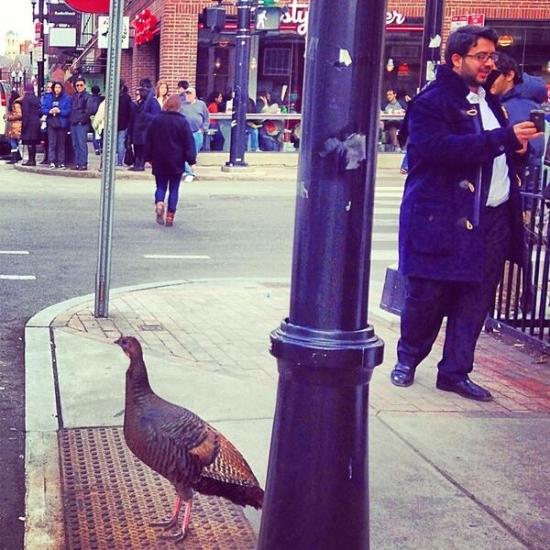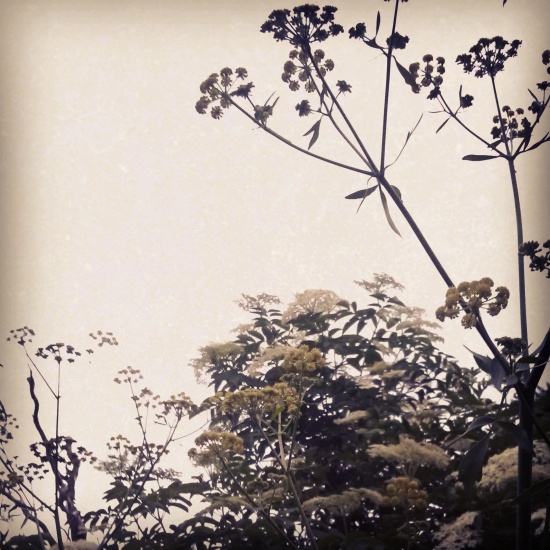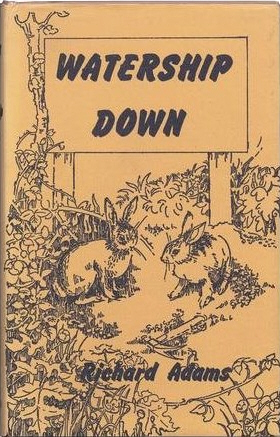
A west coast wild turkey. Source.
I created just a handful of resolutions this year and I think that they are all pretty attainable. Writing more is, as ever, one of them, but when I was mulling over what else to improve upon embracing the wild turkey wasn’t exactly at the top of my list.
This was before I spent New Year’s afternoon having a lazy, prolonged brunch of soda bread and butter with two of my favorite ladies from Milwaukee–Kat, mentioned in the last post, and Erin, who was a guest-blogger in 2013. We were sitting around discussing creatures we have known when Kat asked if I’d seen My Life as a Wild Turkey. I laughed and said no–it sounded like some coming-of-age comedy starring Steve Carell. But Kat insisted I find it. “This guy becomes a turkey mother!” she said. “The birds have their own language!” she added.
It’s impossible for me to say no to any episode of Nature, much less one that purportedly proves that turkeys can talk. So I made a note to watch it and told a few turkey tales of my own.

An amazing shot of a Boston bird by Nick Wilson, aka @Treasure_MA. More wonderful images of our urban turkeys here (with an invitation to submit your own!).
In my first draft of this post I mused that I didn’t know why I hadn’t written more about wild turkeys in the past few years, but now I understand their absence perfectly. In my full-time country farmer days I had some negative experiences with domesticated turkeys which I allowed to foolishly color my appreciation of their cousins. This confession leaves me feeling like Ben Franklin’s summation of the bald eagle: a creature of “bad moral character.” My prejudice was completely uncalled for; anyone that’s worked on an animal farm, or visited one, or ever learned anything about domesticated creatures, knows that intelligence is not something typically selected for in the barnyard. The turkey you had for dinner in November was likely the member of a variety honed for its pure white feathers and capacity for girth. Unless you chose your bird meticulously from a Portlandia episode it wasn’t prized for its high-functioning brain or, for that matter, given a healthy, sunny, non-stressful place to live.
But Wild turkeys. They’re fascinating. And, despite my lousy experiences with their watered-down cousins, they’ve manged to have a hold on me ever since I moved to New England in 2003. There I had friends who told me of the gaggles roaming their lawns and driveways, jogging and strutting through the grass like the Maine State Dinosaur. They sounded bizarre and wonderful and I longed to see some of my own. Eventually I did, but only briefly from car windows while riding shotgun.
The first time that I truly saw them I was on a bike trip in southeastern Wisconsin. I’d been pedaling along, lost in the aimless bliss of a long ride, when suddenly we met.
Wild turkeys are one of those creatures that really embody the eastern woodlands, and I saw them not for the resemblance to their agricultural relations but rather for that forest within. Their feathers, scalloped like mushrooms and smooth like a leaf-littered floor, were the colors of venerable bark and marked in an iridescence like foxfire or beetle shell. Their beaded eyes took in everything–us, the steel curves of our bikes, the roadside knit in prairie remnants and field weeds. The flock was about 15 deep, pecking and wandering in the autumn air. The sun gilt on the tips of the soybean fields we sidled complimented the catching prisms, like petrified wood, wrapped within the wings and tails. I was starstruck.
Looking back, I recognize my time with those Waukesha, Wisconsin turkeys as one of those mystical first time experiences; a sudden, happenstance meeting between two species which for one was illuminating and, for the other, utterly ordinary. (But, you never know. Maybe I really blew those turkeys’ minds with my over-packed messenger bag and bright, red, long-gone bike.)
* * *
Here in Boston I see turkeys fairly often. They’ll walk down the sidewalk, along the river, around the hospital. But my favorite interactions with them occur while working in my clients’ gardens. Most recently I’ve enjoyed watching them wander a sweeping Brookline property. I was pruning a Siberian cypress with a friend when I found a Tom standing on a small cliff that bordered the backyard. An exploratory group of hens surrounded him at distances. They’d cock their heads, lift a tenuous leg, and let it go along with their neck, streamlining their upper bodies for the epicurean rapture of some succulent slug or morbidly obese grub. Gazing at them I was tickled with the exhilaration of being allowed to observe another living thing. You see, turkeys let you really look at them. Unlike many creatures who are easily put off by humans, they’ll kindly allow you to keep an eye on them as long as you also keep your distance. This is a gift that I accept readily and enjoyably, watching their strangely wonderful forms swagger around the city.

Or, if you’re Joe Hutto, you can just snuggle with a turkey and it’s no big deal. Source.
If you’re interested in learning about turkeys, visit The National Wild Turkey Federation. And if you want to hear a deliciously cautionary tale as to why you should never, ever feed a wild animal*, do yourself a favor and listen to one of the best This American Life stories of all time, all about Tom, the psycho killer of Martha’s Vineyard.
As for “My Life as a Turkey,” it’s wonderfully thoughtful and thought-provoking. If you’re on the fence about whether to want to watch a few dozen minutes about a guy hanging out with a bunch of large birds, just think: this is a man obsessed. Joe Hutto raises the turkeys from scratch and, once they’re old enough to venture into the wild, follows them through backwoods Florida. He rarely leaves his property for fear that something could happen to the precious brood. Hutto learns how to coo the language of the jakes and jennys and finds love and brotherhood in the little flock. And…he’s a man; a human who seemingly longs to transform himself wholly into one of the surprisingly elegant and innately wild birds that he so admires. Aren’t you curious to see what happens to a grown man who attempts to fully integrate himself into a gaggle of woodland turkeys? Answer: Yes, yes you are. So watch, enjoy, and tell me what you think.
A second request: the next time that you see a wild turkey, or some other bird that you take for granted and make assumptions about, consider who that creature really is. How does it operate? Does it get by? Consider whether you really have any idea what this living being is all about. It may appear undeniably silly, but the bird before (or above) you may also be able to teach you something about themselves, their environment, and how you tie into all of it.

Wild Turkey by John James Audubon. Source.
* Don’t worry, you can still have a bird feeder. Just not a turkey feeder. Seriously, don’t make a turkey feeder.














